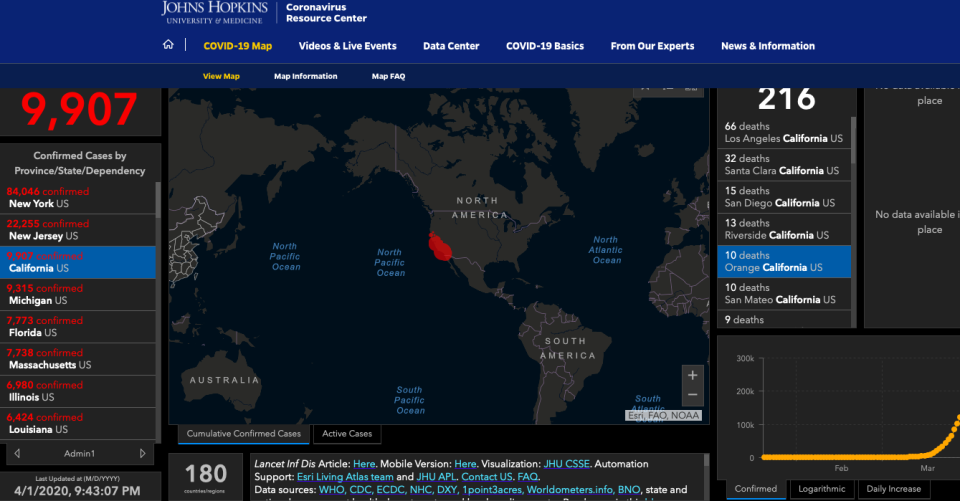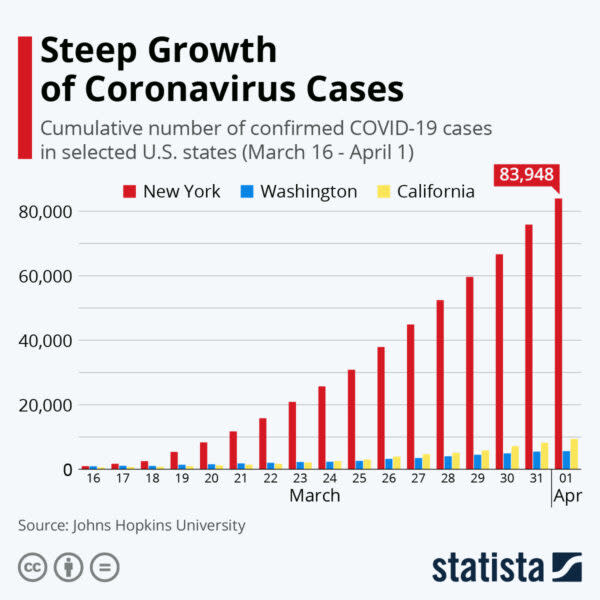Why Isn’t California a Bigger Coronavirus Hot Spot? State Still Has Fewer Cases Than New York

California had 9,816 confirmed coronavirus cases, and 212 deaths, as of Thursday morning, according to the New York Times tracking service. In Los Angeles County, the total confirmed cases have totaled 3,518, according to the county’s Department of Public Health, while the number of deaths has reached 65.
But public health experts wonder why the state — which recorded its first case of the novel coronavirus on Jan. 26 — has not seen as big a surge as hot spots like New York, which has reported 83,889 confirmed cases and 1,941 deaths as of Thursday — with 1,374 in New York City alone.
California’s strict and early shutdowns of nonessential businesses and orders for residents to stay at home may have helped the state avoid an outbreak as severe as New York’s, but health experts told TheWrap that the worst is yet to come in California, and that big cities like Los Angeles still need to prepare for a potential onslaught of seriously ill patients in hospitals.
“I want people to recognize that we’re going to see some things we don’t want to see. We’re going to see a lot more people sick and a lot more people die,” John Swartzberg, an infectious diseases and vaccinology specialist at the UC Berkeley-UCSF Joint Medical Program, told TheWrap. “That’s going to happen no matter what we can do.”

California COVID-19 Cases, Johns Hopkins research
Also Read: CNN's Chris Cuomo Announces He Tested Positive for Coronavirus
As has been extensively reported, the data surrounding the number of coronavirus cases in the U.S. is flawed and imprecise, largely because not enough people are being tested. As of March 31, the California Department of Public Health reported the completion of 31,038 tests, with another 59,100 pending. That’s significantly less than the 220,880 New Yorkers who had been tested as of March 31, according to New York State’s public health department.
Further, comparisons between states are flawed because of differences in population and population density. But in terms of the curve of infection, California appears to have made positive strides in reducing the severity of the outbreak, even though the numbers of cases and deaths have continued to increase significantly each day.
“We are in a completely different place than the state of New York, and I hope we continue to be, but we won’t unless people continue practicing social distancing,” Gov. Gavin Newsom said during a Wednesday afternoon press conference.
Also Read: California Gov. Gavin Newsom Orders All Residents Statewide to Stay at Home

Statistica
One reason for that may be the early action on the part of state and local officials. On March 16, six counties in California’s Bay Area — San Francisco, Santa Clara, San Mateo, Marin, Contra Costa and Alameda — announced a “shelter in place” order and closed nonessential businesses, launching one of the strictest orders issued in the U.S. at the time. Three days later, Los Angeles followed suit with a “safer at home” order, hours before California’s governor issued a statewide “stay at home” order that will last indefinitely.
George Rutherford, the head of UCSF’s Division of Infectious Disease and Global Epidemiology, said that “shelter in place” or “stay at home” orders are most effective when they’re put in place before there’s widespread transmission of a highly contagious disease. “All our indications are that this is working,” Rutherford said of California’s early and aggressive social distancing measures.
There are, of course, other geographic or cultural factors that may have given California an advantage in its fight against COVID-19 compared to states like New York, public health experts told TheWrap.
Some of the main factors influencing a region’s infection rate include the number of people, the average distance between people, the number of interactions people are having with one another, whether people are moving between centers of infection, when the virus arrived, public health interventions and the number of tests conducted, Robert Siegel, a microbiology and immunology professor at Stanford, said.
Also Read: LA County Closes All Public Beaches, Trails and Piers Through April 19
And in New York, certain lifestyle differences — such as the concentration of people living and working in small areas and the widespread use of the subway and other public transport systems — means that more people are interacting more closely with one another. “Even in grocery stores, because of the cost of real estate, their aisles are closer together. So they have a lot of interactions,” Siegel said.
Neal Baer, an adjunct professor in UCLA’s Department of Community Health Sciences, said that Los Angeles’ “car culture,” together with the city’s “safer at home” order, could be another “critical reason” as to why Angelenos have not yet seen as high a number of cases. “That’s not to say that people don’t get exposed in Los Angeles, but maybe we’re less exposed,” Baer said. “Two weeks ago, we were already sheltering, and we were in our cars weeks before then.”
Still, health experts said that maintaining aggressive social distancing measures — alongside increasing the number of tests, protective gear and medical equipment like ventilators and ICU beds in hospitals — will be key to reducing the severity of the coronavirus outbreak in California and, for that matter, any other state in the U.S.
“If it’s not done uniformly across the country,” Rutherford said, “the virus is going to continue to get reintroduced into the places that have done the right thing, and our effort will be for naught.”
And aggressive measures on a city, state and federal level, health experts cautioned, can’t end when the coronavirus pandemic seems to be waning, either.
“People say that we couldn’t afford to, but we’ve somehow found the money to fund a standing army that’s the largest in the world. And the reason we’ve done that is because the population believes that we need to protect ourselves, not from a war that’s happening now, but from a war that might occur,” Swatzberg said. “We know there’s going to be recurrent pandemics. There always have been and there are going to be until our science is a lot better. Why haven’t we prepared for that?”
Read original story Why Isn’t California a Bigger Coronavirus Hot Spot? State Still Has Fewer Cases Than New York At TheWrap


